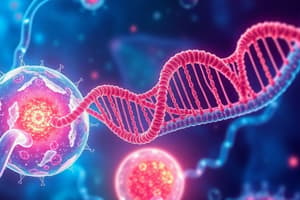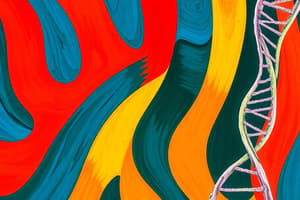Podcast
Questions and Answers
Which statement accurately describes the distribution of ribosomes within a cell?
Which statement accurately describes the distribution of ribosomes within a cell?
- Ribosomes are predominantly associated with the Golgi apparatus.
- Ribosomes are distributed throughout the cell, including both the nucleus and cytoplasm. (correct)
- Ribosomes are present only in the cytoplasm.
- Ribosomes are exclusively found within the nucleus.
Which of the following options includes all major types of cytoskeletal elements found in eukaryotic cells?
Which of the following options includes all major types of cytoskeletal elements found in eukaryotic cells?
- Microtubules and endoplasmic reticulum
- Intermediate filaments and flagella
- Microfilaments and ribosomes
- Intermediate filaments, microfilaments, and microtubules (correct)
What type of cell junction facilitates communication between adjacent plant cells by allowing the passage of water and small molecules?
What type of cell junction facilitates communication between adjacent plant cells by allowing the passage of water and small molecules?
- Adherens junctions
- Tight junctions
- Plasmodesmata (correct)
- Gap junctions
During the early era of cell biology, who was the first to visually identify and assign the name 'cells' to the structures he observed?
During the early era of cell biology, who was the first to visually identify and assign the name 'cells' to the structures he observed?
In the double helix structure of DNA, adenine forms a complementary base pair with which other nitrogenous base?
In the double helix structure of DNA, adenine forms a complementary base pair with which other nitrogenous base?
When a cell expands in diameter, how do volume and surface area increase, respectively?
When a cell expands in diameter, how do volume and surface area increase, respectively?
Which of the following is a key difference between eukaryotic and prokaryotic cells?
Which of the following is a key difference between eukaryotic and prokaryotic cells?
Motor proteins are essential for cellular movements. Which of the following is an example of a motor protein's function?
Motor proteins are essential for cellular movements. Which of the following is an example of a motor protein's function?
During DNA replication, several enzymes play crucial roles. What is the primary function of DNA polymerase?
During DNA replication, several enzymes play crucial roles. What is the primary function of DNA polymerase?
In a typical human karyotype, how many pairs of autosomes are present?
In a typical human karyotype, how many pairs of autosomes are present?
What structural difference distinguishes RNA from DNA?
What structural difference distinguishes RNA from DNA?
Codons are essential for the process of translation. What is the role of a codon?
Codons are essential for the process of translation. What is the role of a codon?
Mitosis and meiosis are two types of cell division. What is a key difference between them concerning chromosome number?
Mitosis and meiosis are two types of cell division. What is a key difference between them concerning chromosome number?
Flashcards
Cytoskeletal Elements
Cytoskeletal Elements
Filaments that maintain cell shape, enable cell movement and intracellular transport.
Plasmodesmata
Plasmodesmata
Cell junctions that act as channels between plant cells for communication and transport.
Who named 'cells'?
Who named 'cells'?
The scientist who first sketched and named 'cells'.
Adenine pairs with?
Adenine pairs with?
Signup and view all the flashcards
What is chromatin?
What is chromatin?
Signup and view all the flashcards
Who sketched cells first?
Who sketched cells first?
Signup and view all the flashcards
Prokaryotic vs. Eukaryotic Cells
Prokaryotic vs. Eukaryotic Cells
Signup and view all the flashcards
Mitochondria & ER Functions
Mitochondria & ER Functions
Signup and view all the flashcards
What is cytoskeleton?
What is cytoskeleton?
Signup and view all the flashcards
DNA Base Pairing
DNA Base Pairing
Signup and view all the flashcards
mRNA, rRNA, tRNA Functions
mRNA, rRNA, tRNA Functions
Signup and view all the flashcards
Mitosis vs. Meiosis
Mitosis vs. Meiosis
Signup and view all the flashcards
Mitosis Stages
Mitosis Stages
Signup and view all the flashcards
Study Notes
- Robert Hooke was the first person to sketch and name cells.
- When a cell expands in diameter, volume increases by the cube of the diameter, and surface area increases by the square of the diameter.
Prokaryotic vs. Eukaryotic Cells
- Prokaryotic cells do not have a true nucleus.
- Eukaryotic cells have a true nucleus.
Cell Component Functions
- Mitochondria: Produce ATP through cellular respiration.
- Endoplasmic Reticulum:
- Rough ER: Involved in protein synthesis and modification.
- Smooth ER: Involved in lipid synthesis and detoxification.
Cell Junctions
- Plasmodesmata are cell junctions not found in animal cells (they are found in plant cells).
Cytoskeleton Types
- Microfilaments
- Intermediate filaments
- Microtubules
Motor Proteins
- Motor proteins produce motion in the cell.
- Examples: Myosin, Kinesin, and Dynein.
DNA Structure
- DNA has a double helix structure.
- The backbone consists of alternating sugar and phosphate groups.
- Nitrogenous bases (Adenine, Thymine, Guanine, Cytosine) are attached to the sugar.
DNA Building Blocks
- Nucleotides are the building blocks of DNA.
- Each nucleotide consists of a deoxyribose sugar, a phosphate group, and a nitrogenous base.
Base Pairing in DNA
- Adenine (A) pairs with Thymine (T).
- Guanine (G) pairs with Cytosine (C).
DNA Replication
- DNA replication is the process of copying DNA.
- Enzymes involved:
- Helicase: Unwinds the DNA double helix
- DNA Polymerase: Synthesizes new DNA strands by adding nucleotides to the 3' end of a template strand.
- Ligase: Joins DNA fragments.
Therapeutic Cloning
- Therapeutic cloning aims to create new, replacement tissues for nerves, heart, and muscles.
Human Karyotype
- A typical human karyotype has 22 pairs of autosomes and 1 pair of sex chromosomes, for a total of 23 pairs.
RNA vs. DNA
- RNA contains ribose sugar, while DNA contains deoxyribose sugar.
- RNA contains uracil (U) instead of thymine (T).
- RNA is typically single-stranded, while DNA is double-stranded.
RNA Classes
- Messenger RNA (mRNA): Carries genetic information from DNA to ribosomes.
- Ribosomal RNA (rRNA): A structural component of ribosomes.
- Transfer RNA (tRNA): Carries amino acids to ribosomes during protein synthesis.
DNA and RNA Synthesis Enzymes
- DNA Polymerase: involved in DNA synthesis
- RNA Polymerase: involved in RNA synthesis.
Gene Definition
- A gene is a segment of DNA that specifies a sequence of amino acids in a polypeptide.
Translation Stages
- Initiation: mRNA binds to the ribosome, and the first tRNA brings the first amino acid.
- Elongation: tRNA molecules bring amino acids to the ribosome, and peptide bonds form between the amino acids.
- Termination: A stop codon is reached, and the polypeptide is released from the ribosome.
Codons and Anticodons
- Codons are sequences of three nucleotides in mRNA that specify particular amino acids.
- Anticodons are sequences of three nucleotides in tRNA that are complementary to mRNA codons.
The Genetic Code
- The genetic code contains 64 mRNA codons (triplets).
Stop Codons
- The triplets of stop codons are UAA, UAG, and UGA.
Amino Acids
- There are 20 amino acids in nature.
Mitosis vs. Meiosis
- Mitosis results in two identical daughter cells, while meiosis results in four genetically different daughter cells.
- Mitosis is involved in growth and repair, while meiosis is involved in sexual reproduction.
- Somatic cells undergo mitosis, while germ cells undergo meiosis.
Chromosome Number
- Somatic cells are diploid (2n).
- Gametes are haploid (n).
Mitosis Stages
- Prophase: Chromosomes condense, and the nuclear envelope breaks down.
- Metaphase: Chromosomes line up along the metaphase plate.
- Anaphase: Sister chromatids separate and move to opposite poles of the cell.
- Telophase: Chromosomes arrive at opposite poles, and the nuclear envelope reforms.
Cytokinesis
- Cytokinesis is cytoplasmic cell division.
- In animal cells, cytokinesis involves the formation of a cleavage furrow.
- In plant cells, cytokinesis involves the formation of a cell plate.
Tumors
- Benign tumors: Non-cancerous and do not spread to other parts of the body.
- Malignant tumors: Cancerous and can spread to other parts of the body (metastasis).
Common Features of Prokaryotic and Eukaryotic Cells
- Plasma membrane
- DNA
- Cytoplasm
Cloning
- Cloning an adult mammal does not have or bypasses meiosis, gamete formation, and fertilization.
Eukaryotic Cell Features
- Golgi bodies
- True nucleus
- Use organelles for compartmentalization
- A dynamic "skeleton" of proteins
Rough Endoplasmic Reticulum
- The rough endoplasmic reticulum is characterized by the presence of ribosomes throughout.
Cytoskeletal Elements
- Intermediate filaments
- Microfilaments
- Microtubules
Cell Junctions in Plant Cells
- Plasmodesmata are cell junctions found in plant cells.
Adenine Pairing
- In DNA structure, adenine only pairs with thymine.
Chromatin
- All DNA and its associated proteins in the nucleus is termed chromatin.
ATP Production
- Eukaryotic cells make most of their ATP in mitochondria.
DNA Building Block
- Uracil is a nucleotide which is not a DNA building block.
DNA Nucleotide
- A DNA nucleotide contains a nitrogen-containing base, a sugar, and a phosphate group.
Studying That Suits You
Use AI to generate personalized quizzes and flashcards to suit your learning preferences.




